
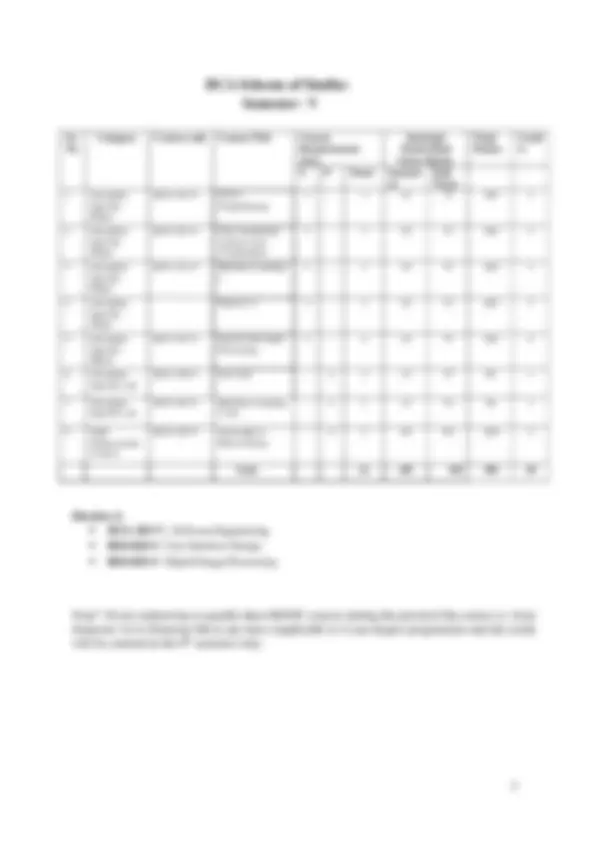
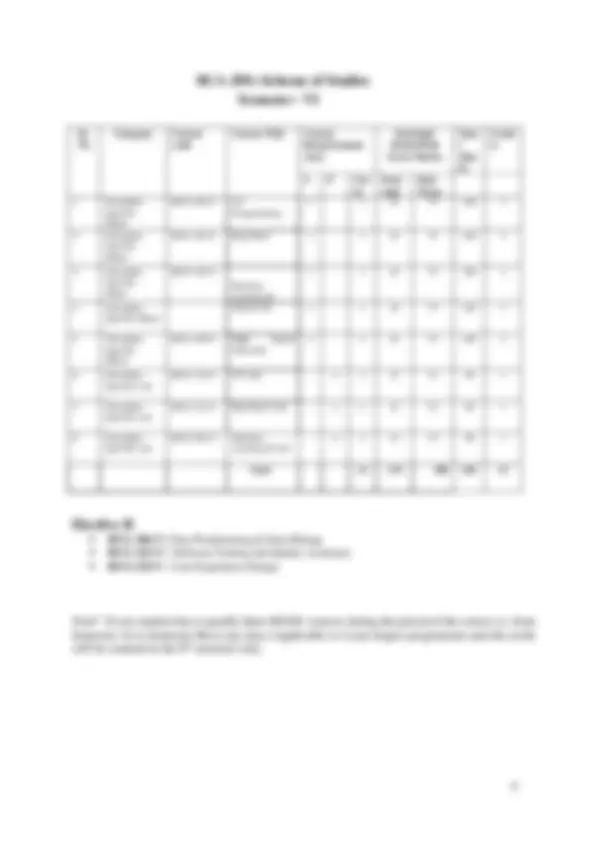
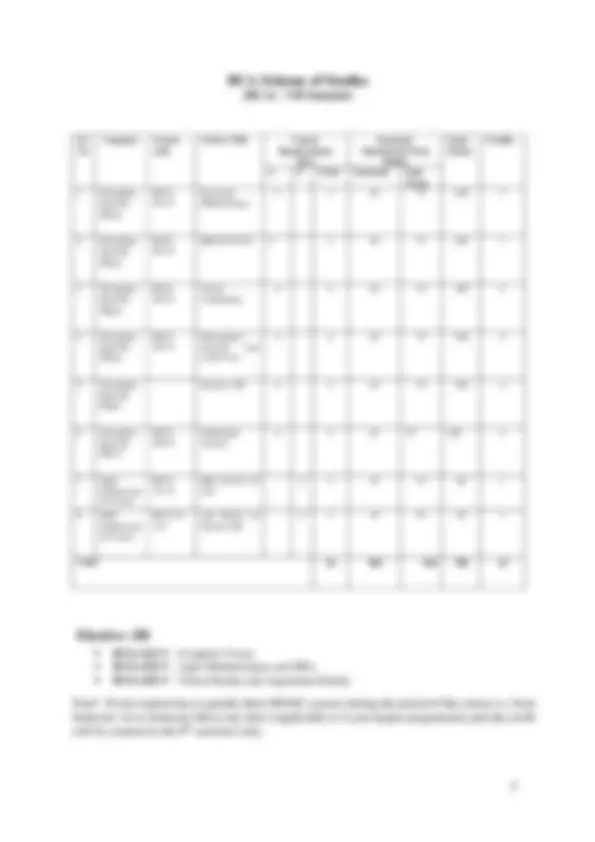
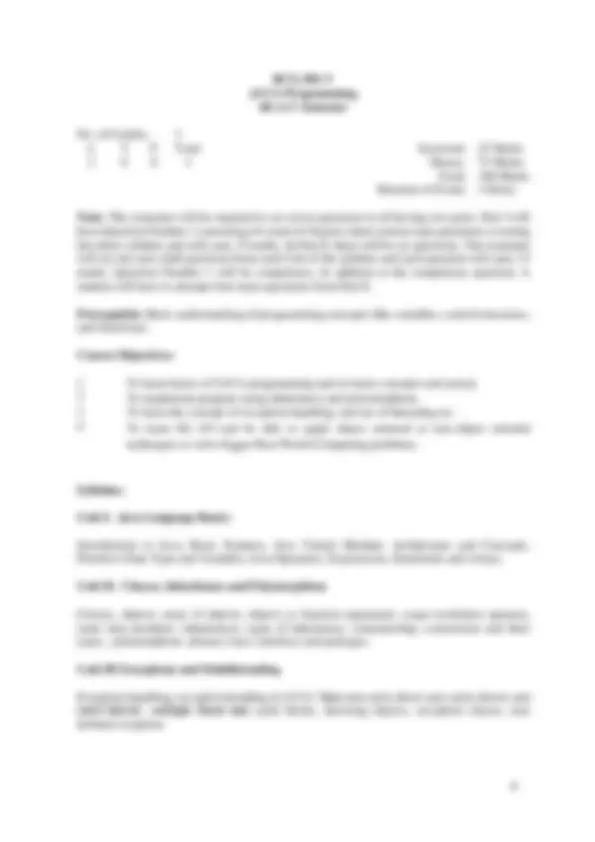
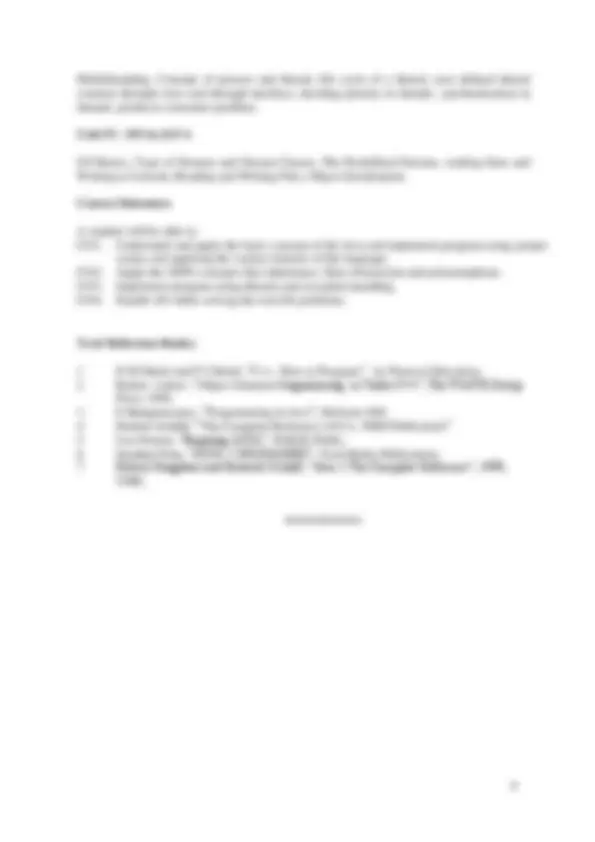
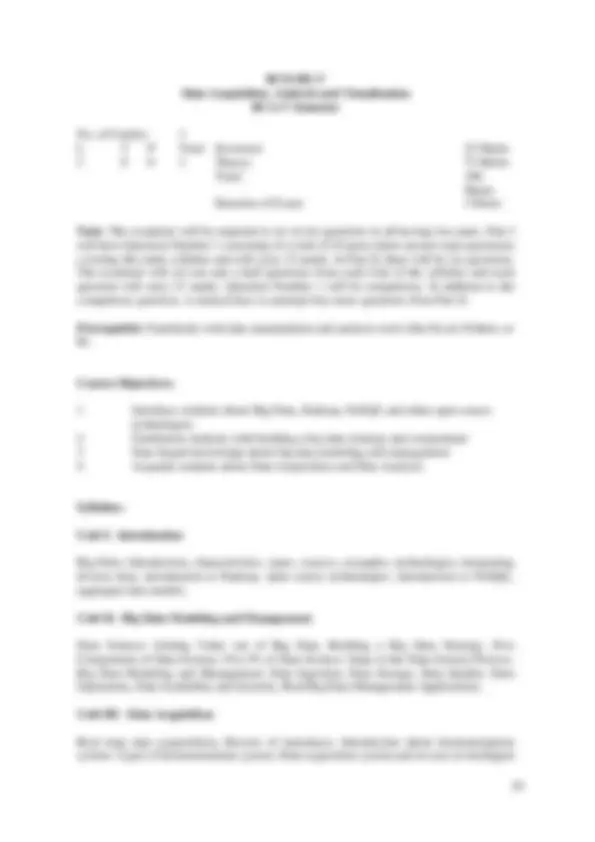

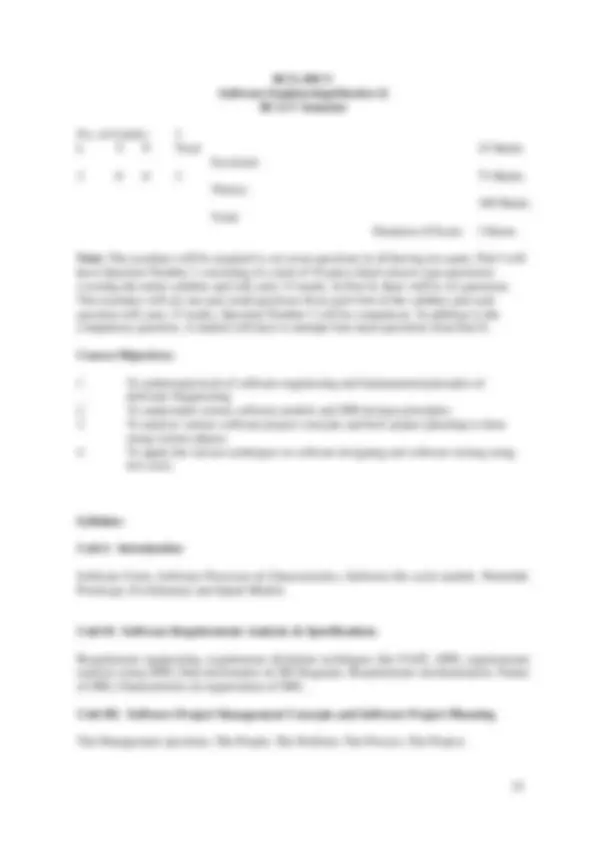
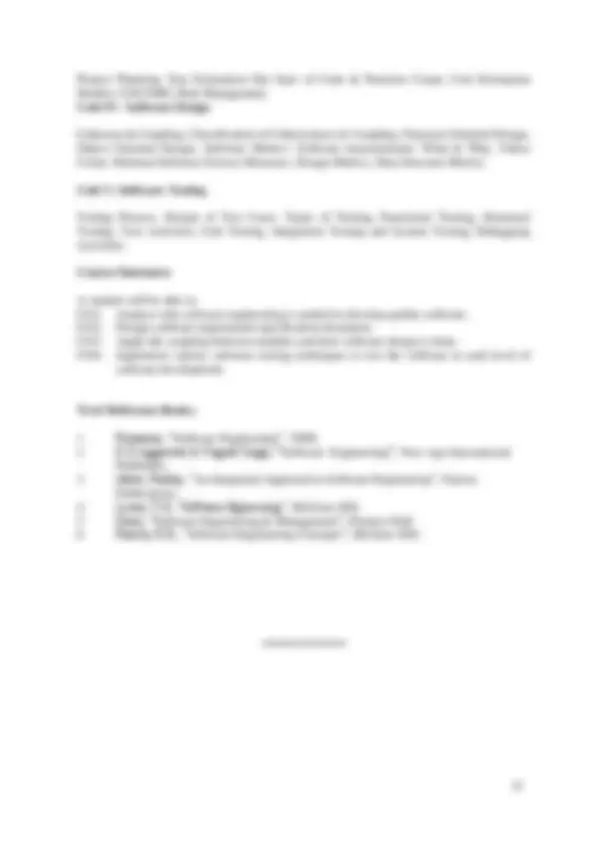
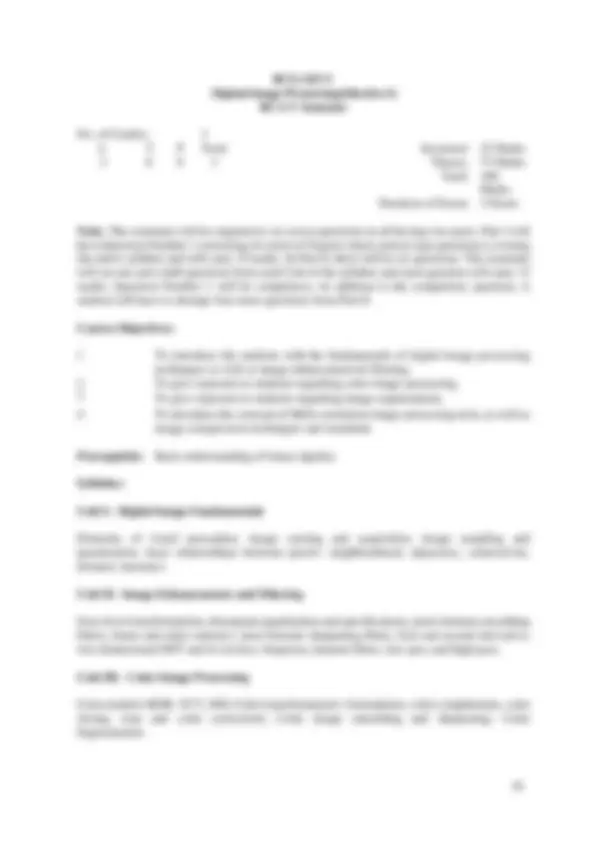
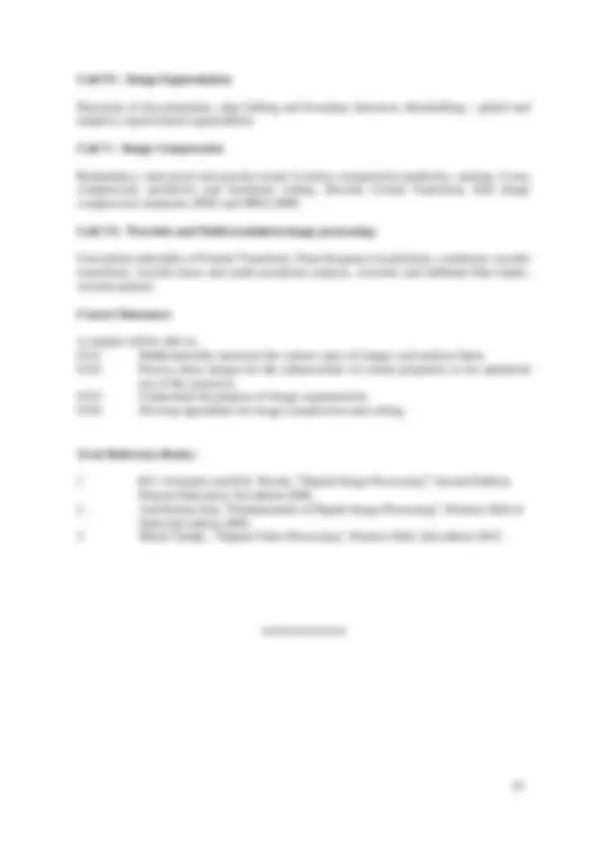
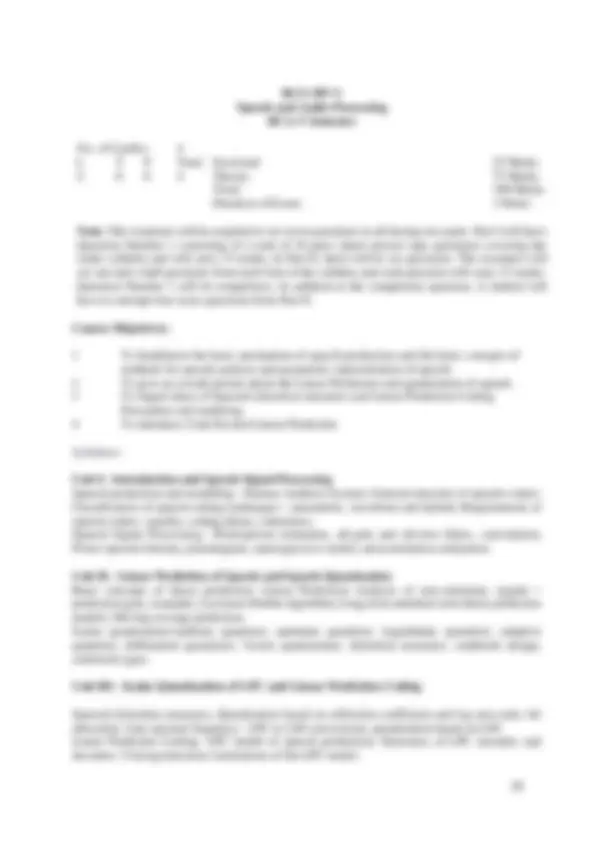
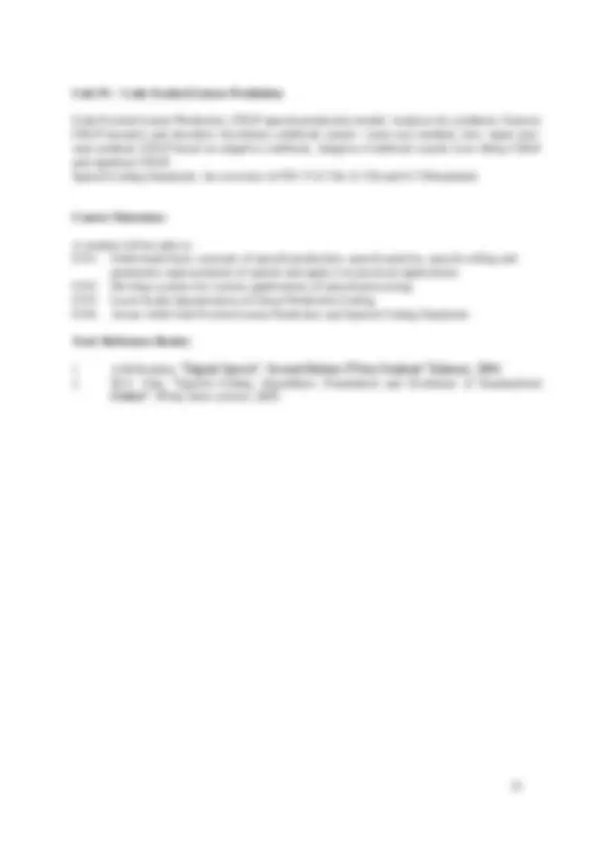
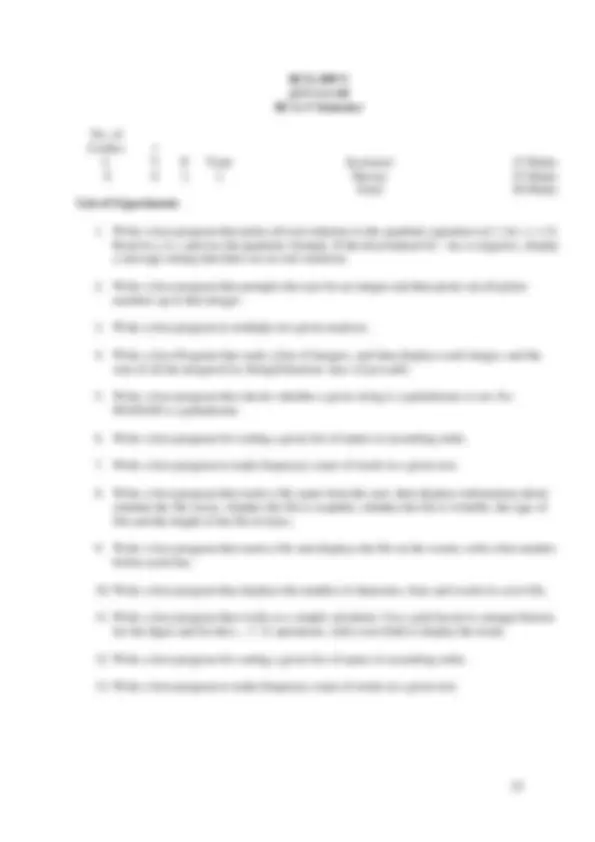
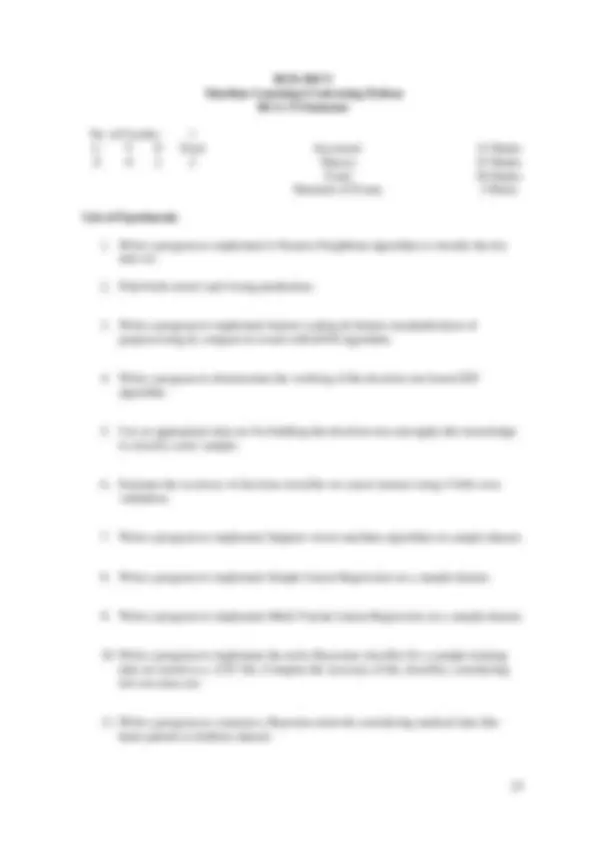
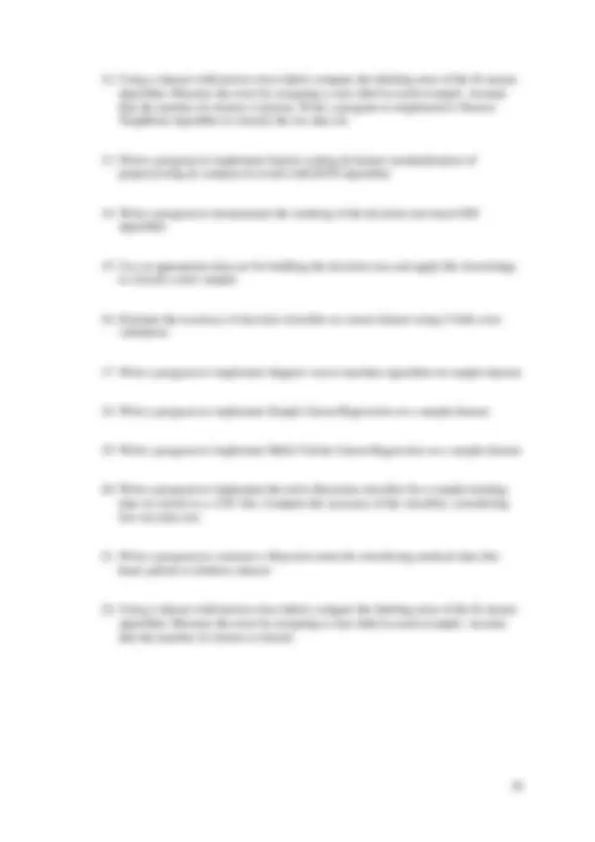
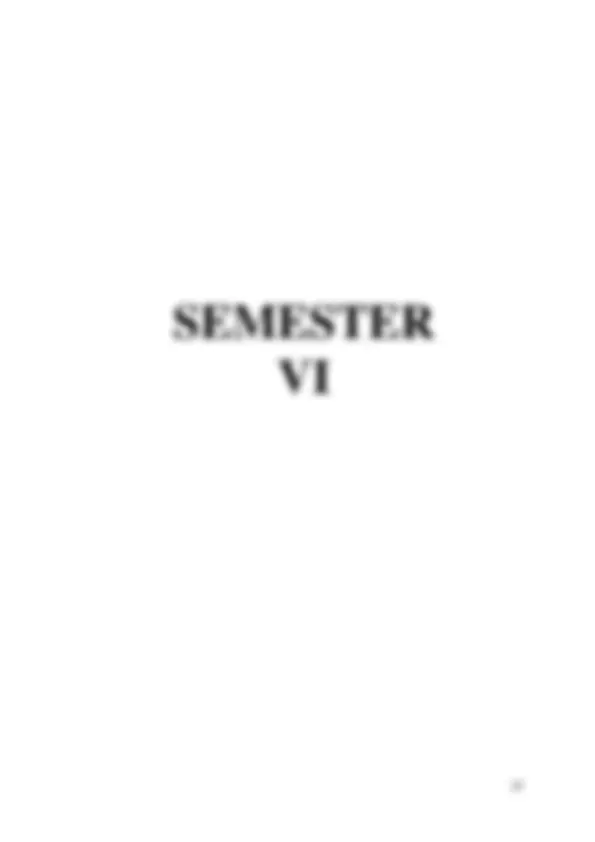
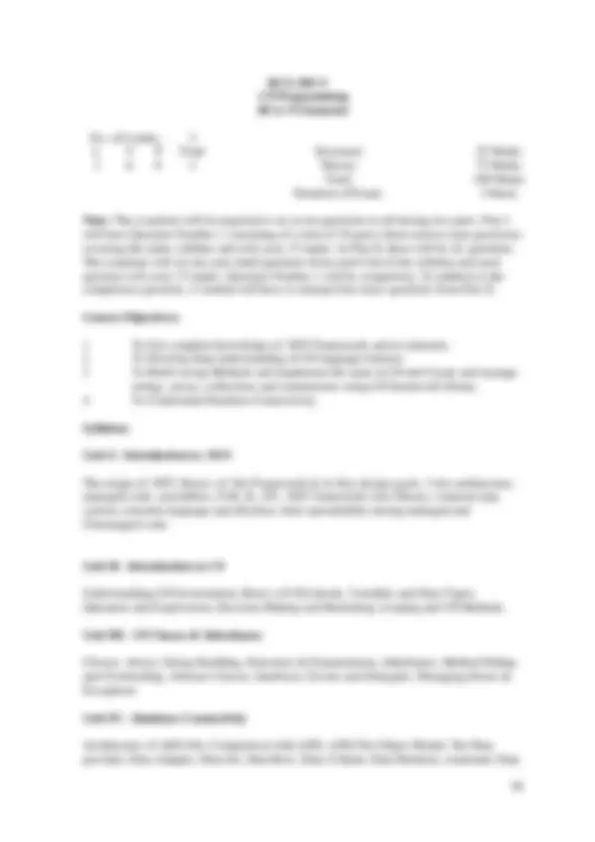
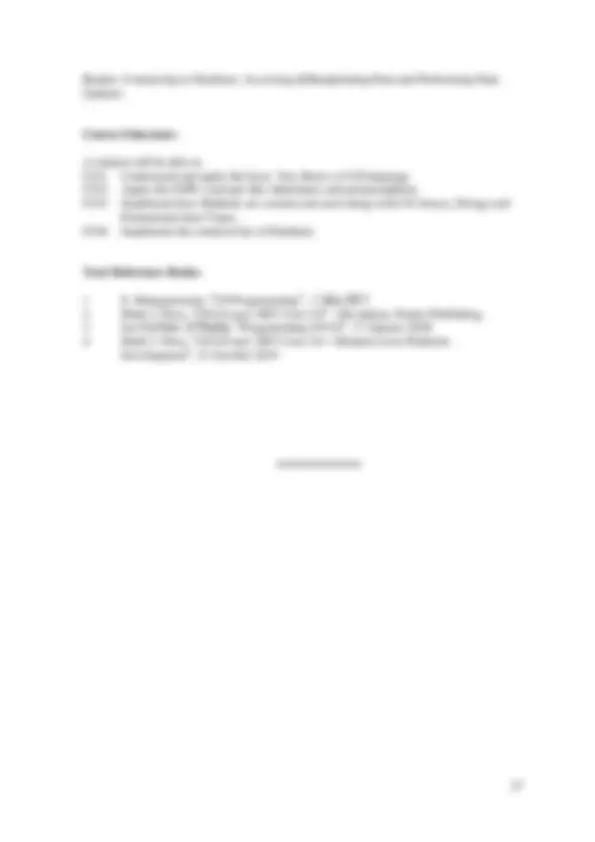
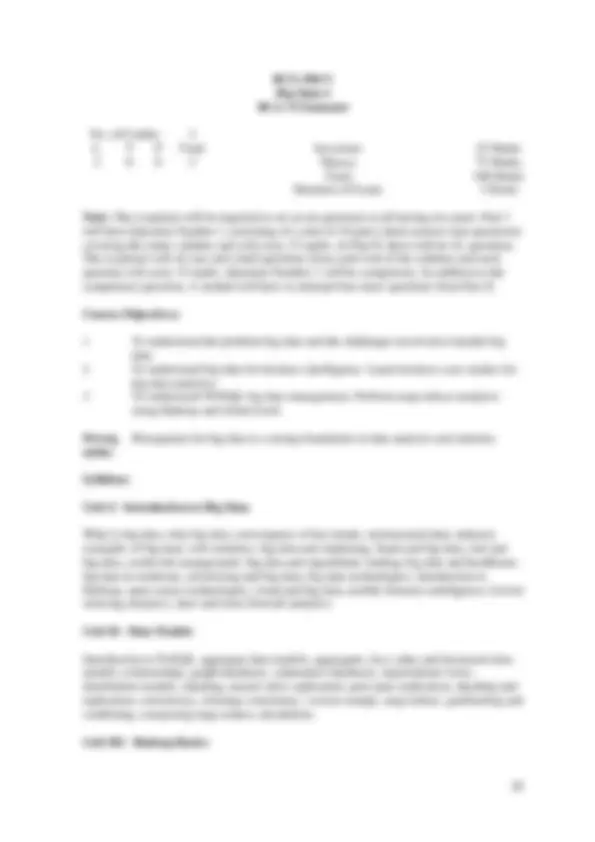
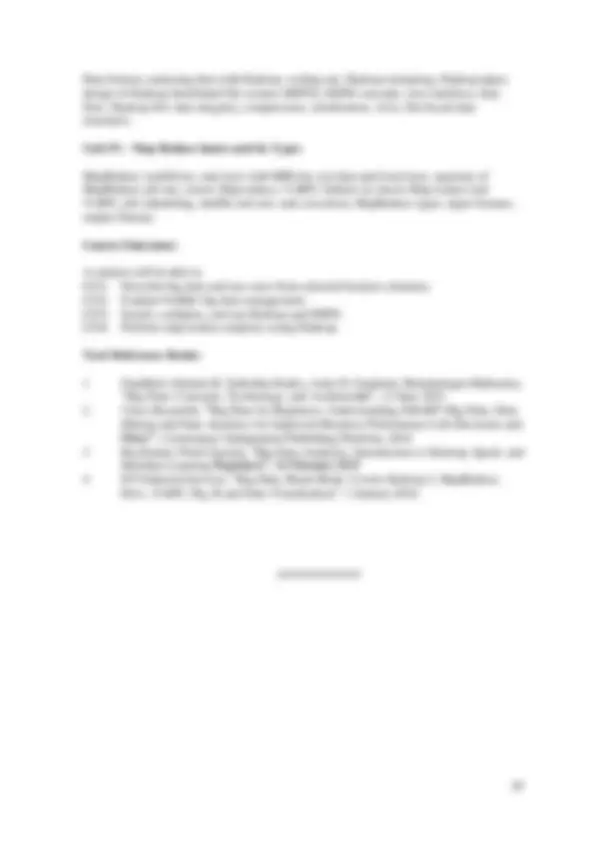
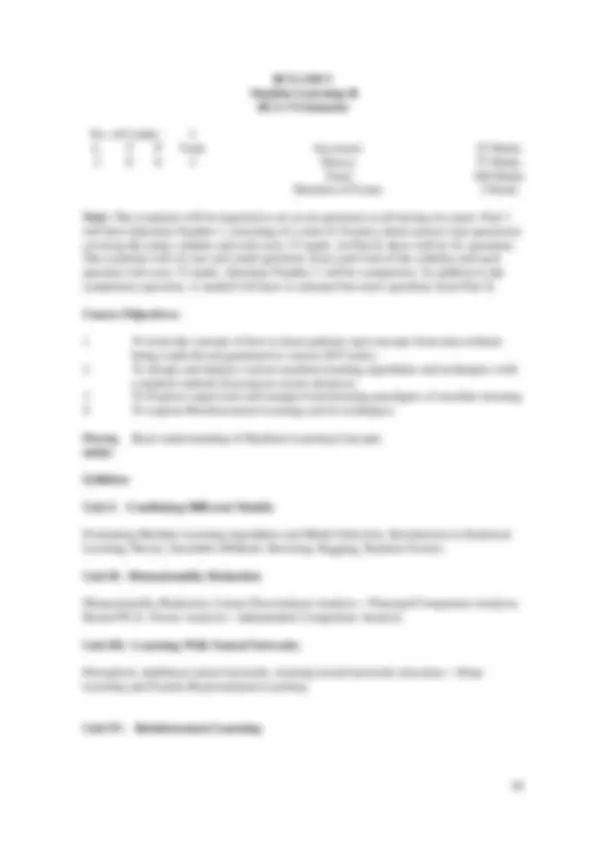
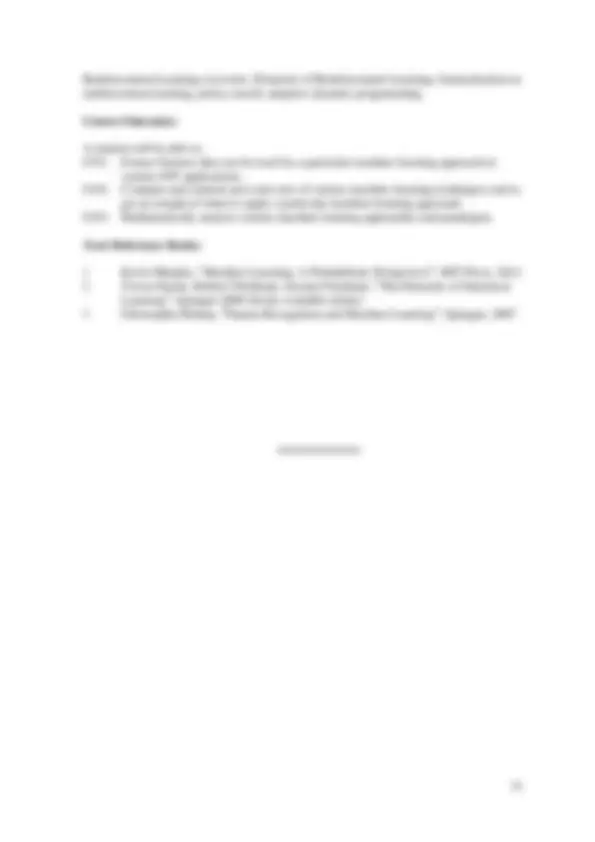
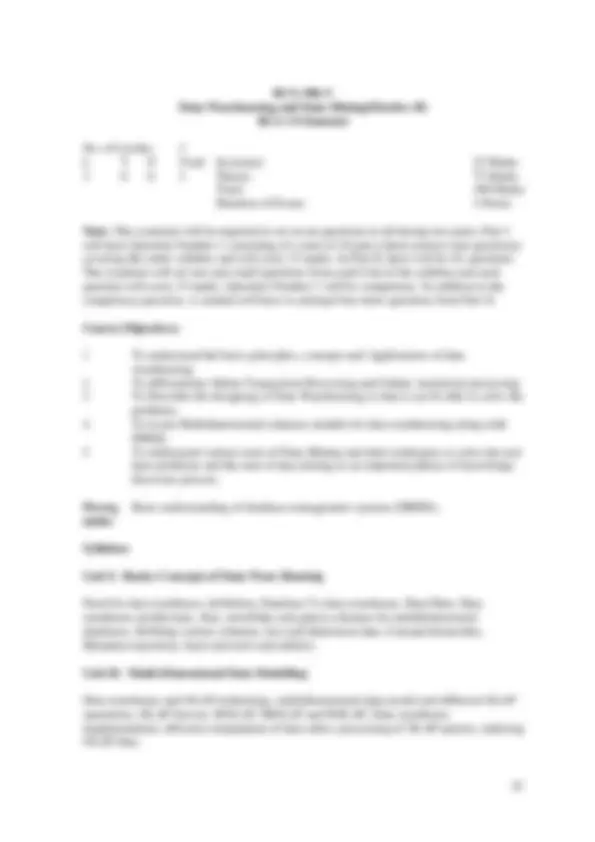
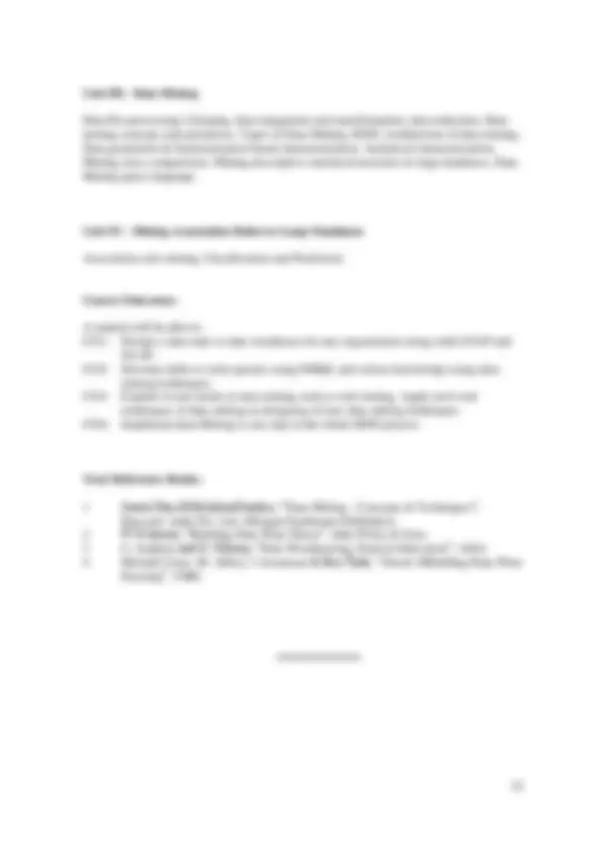
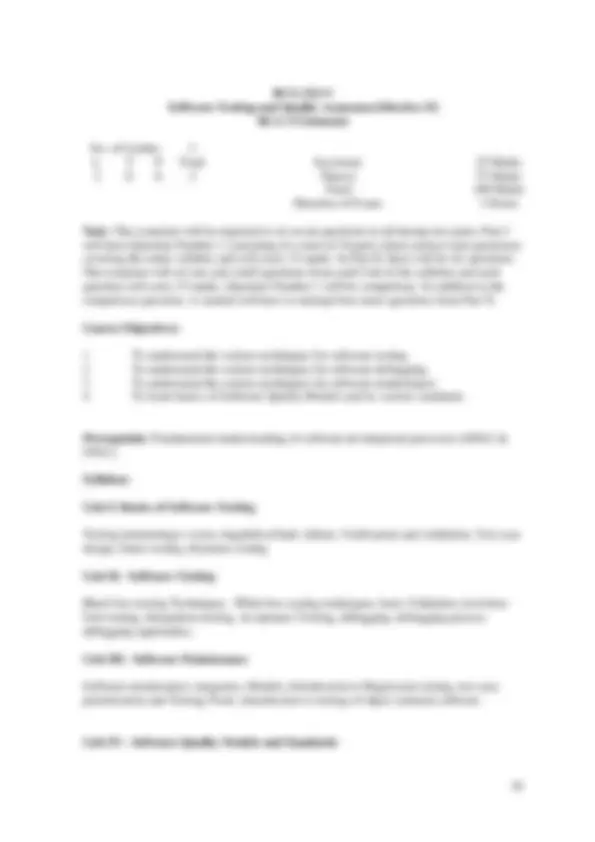
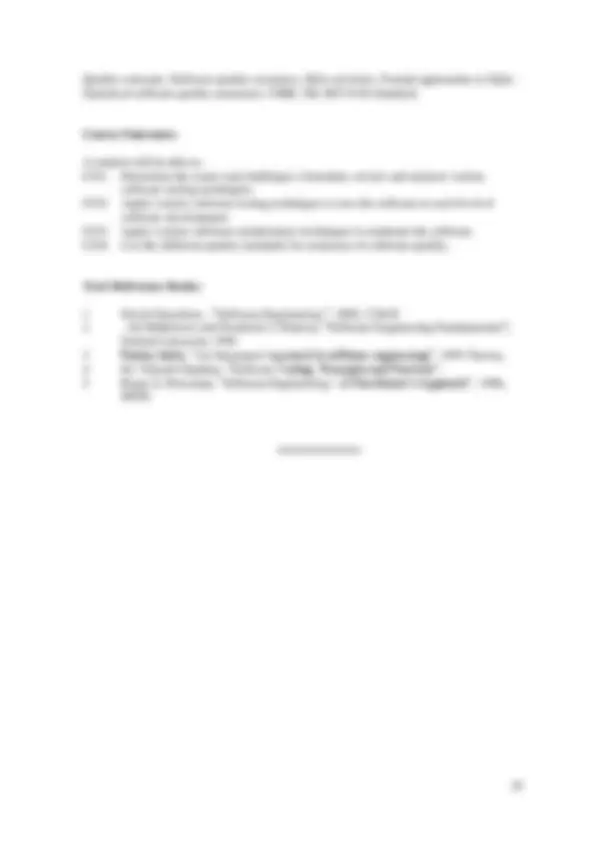
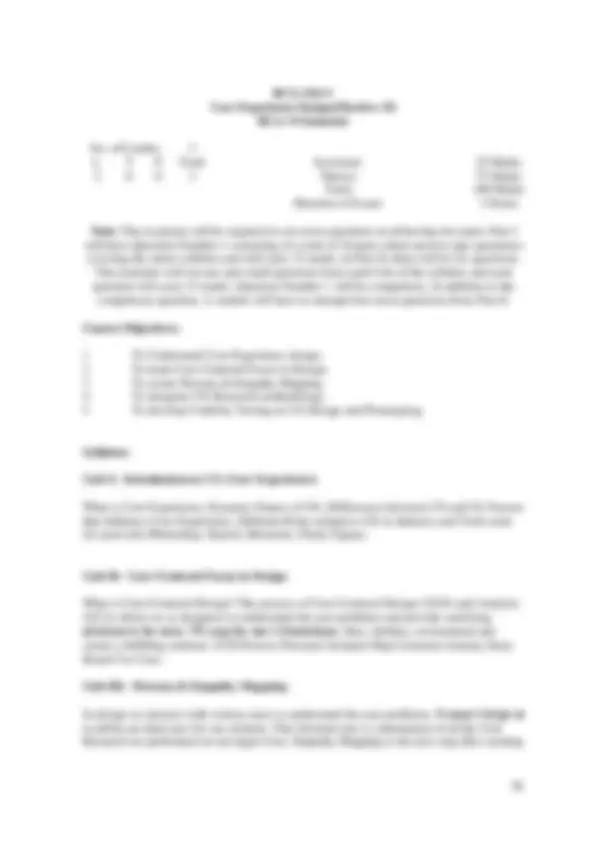
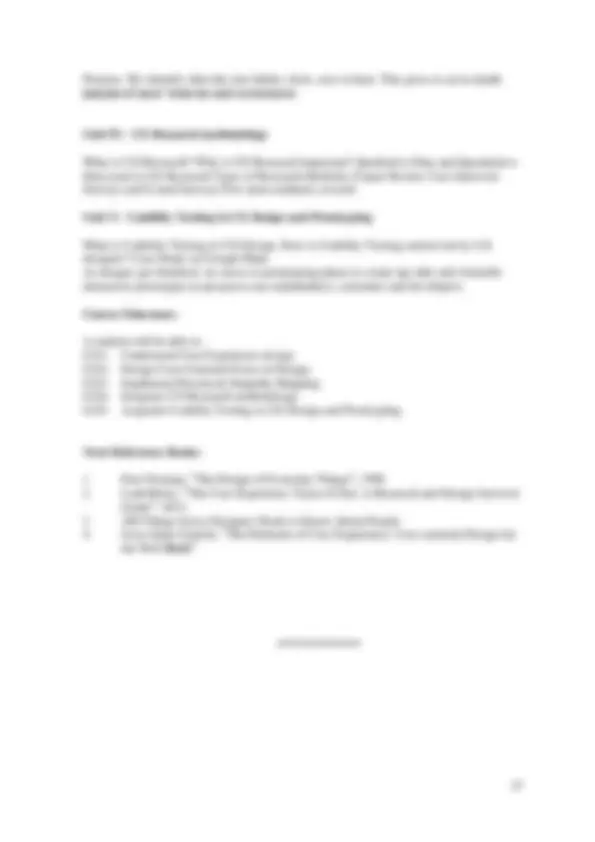
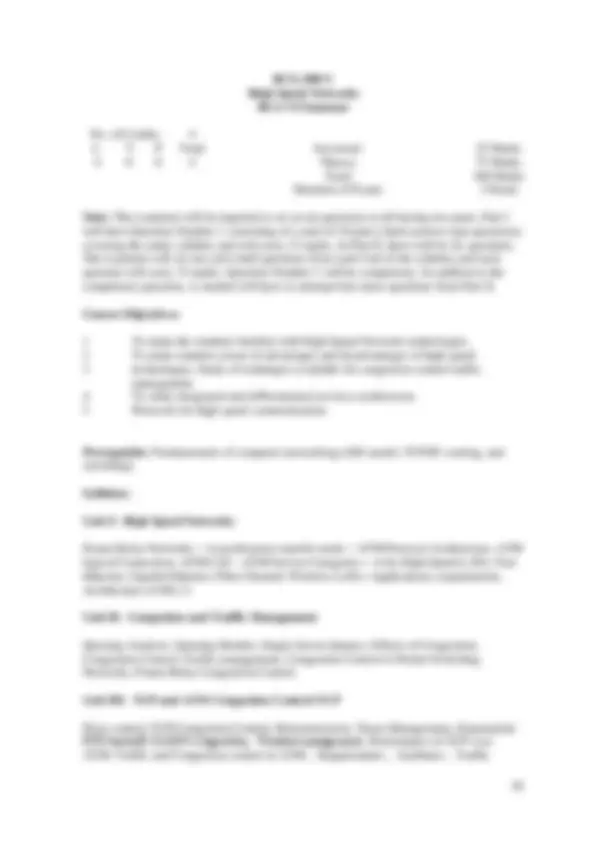
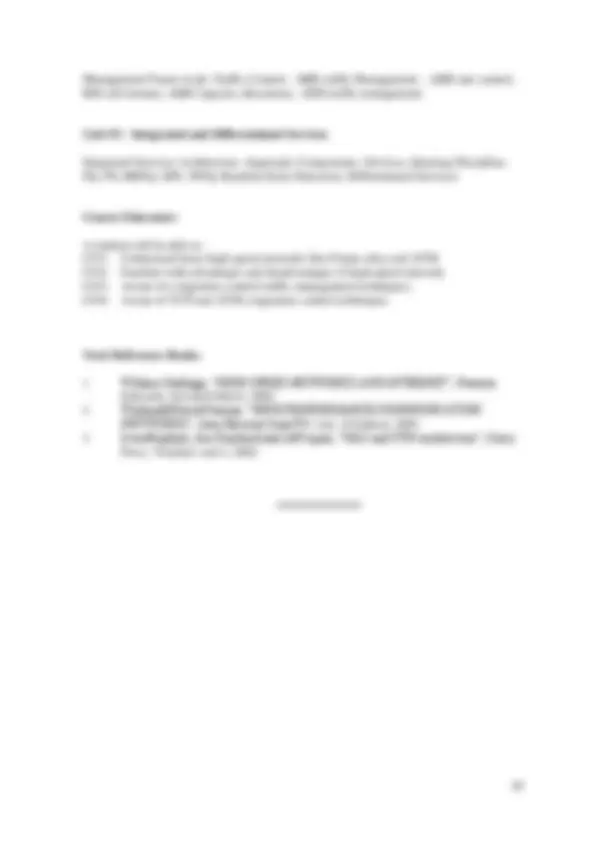
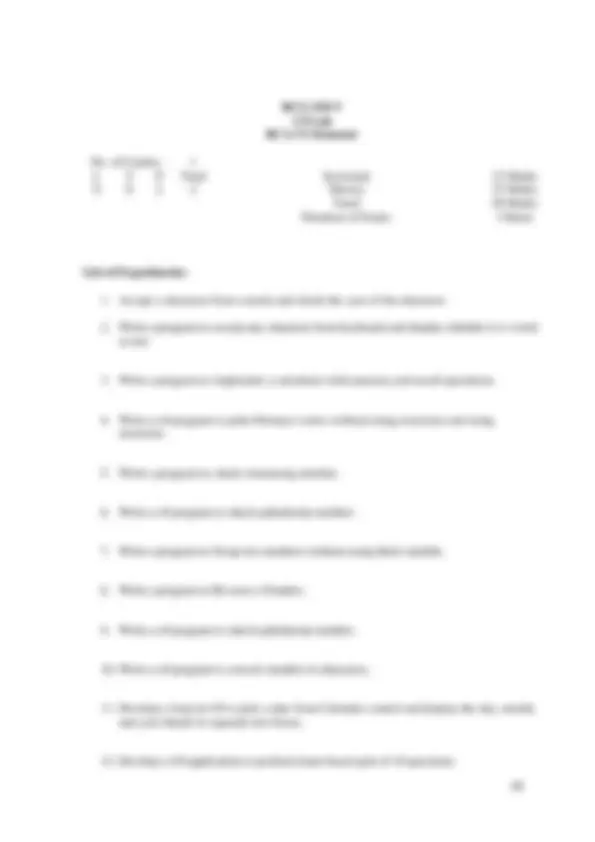

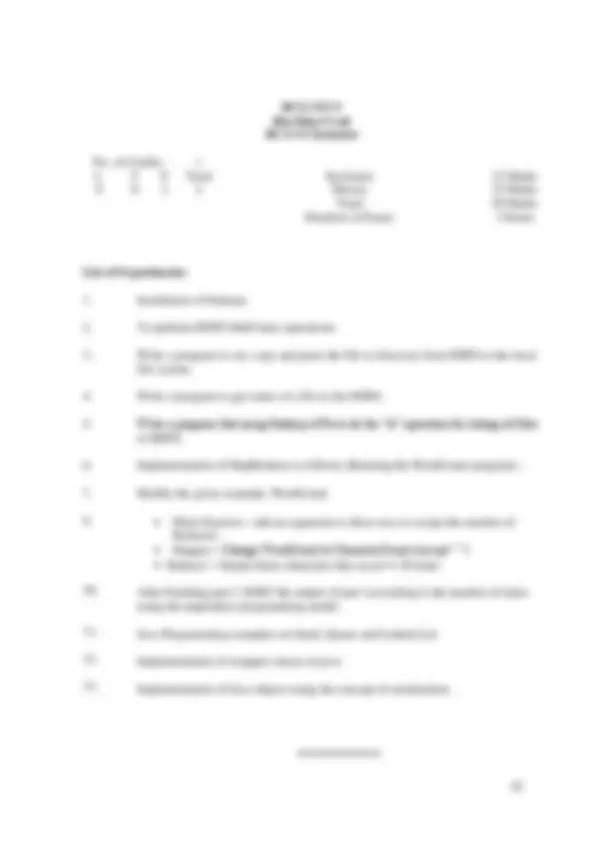
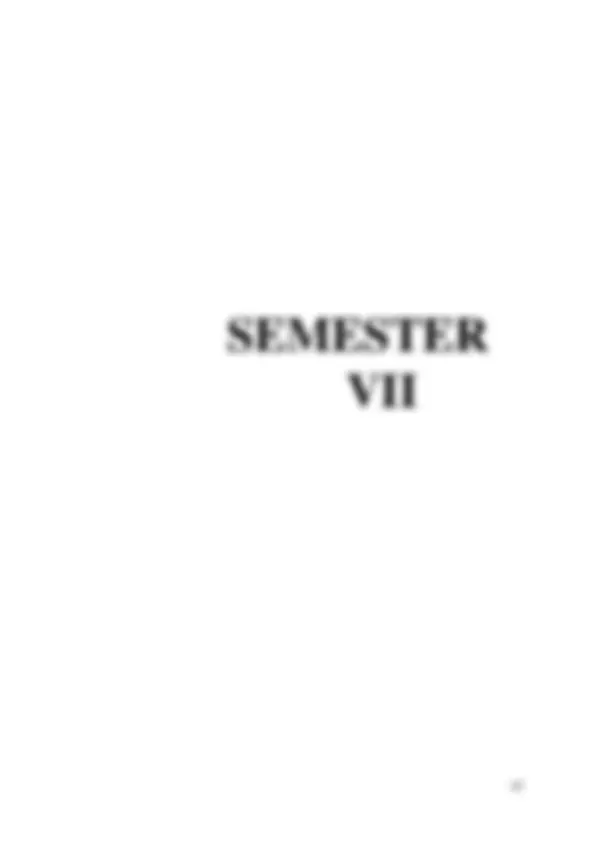
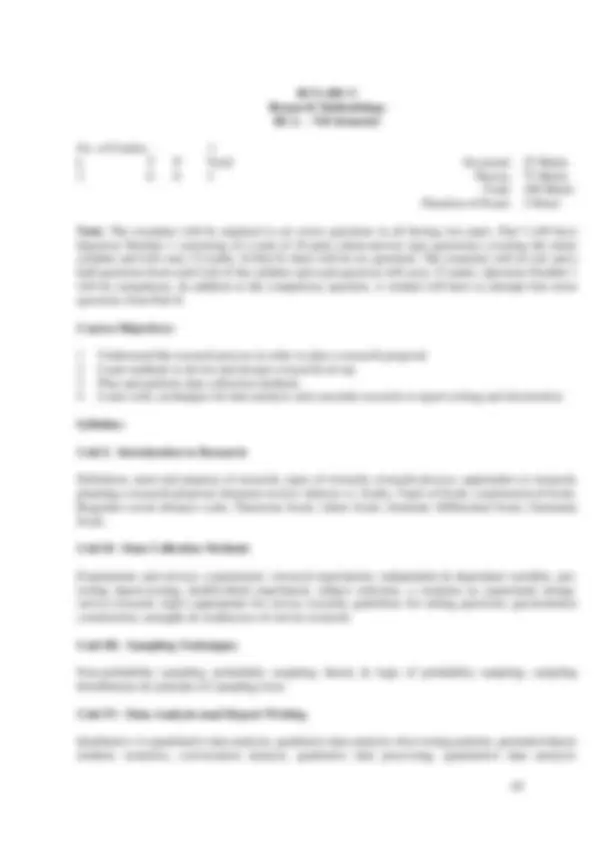
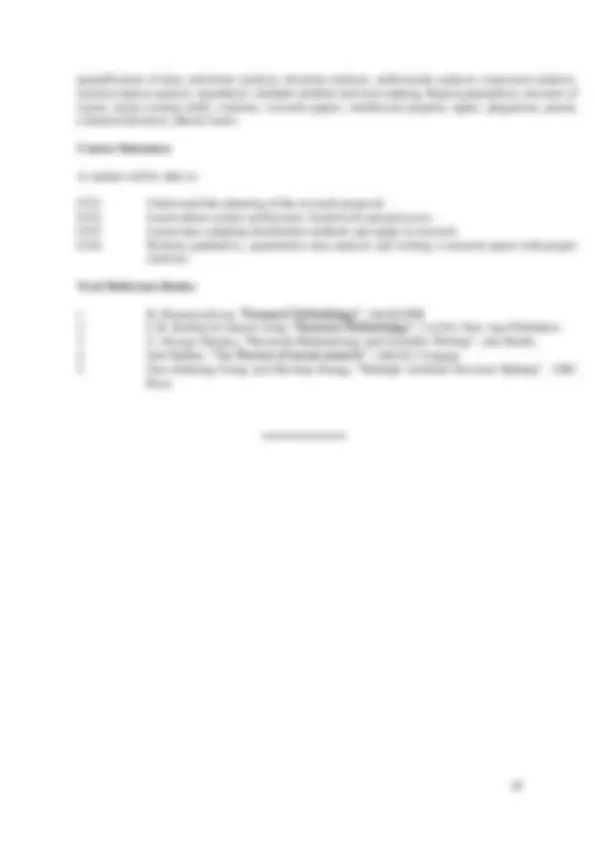
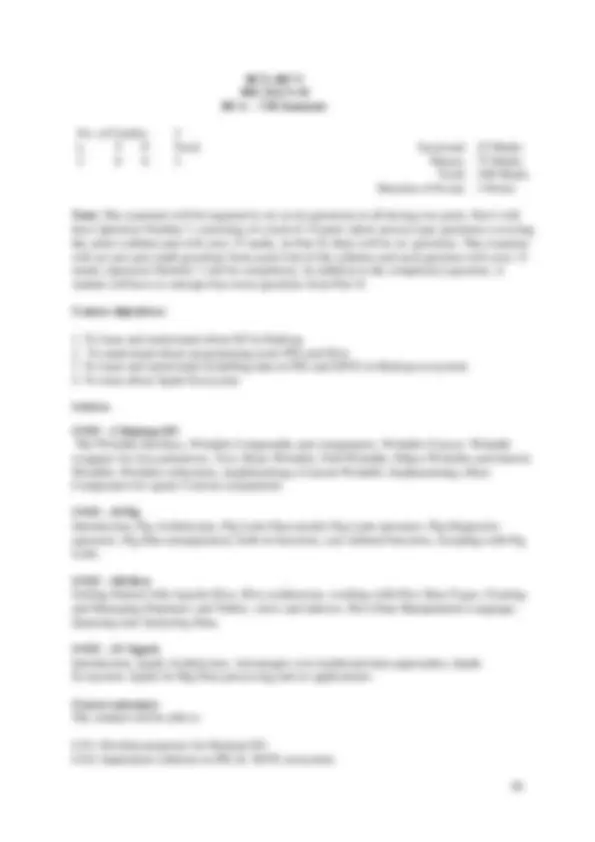

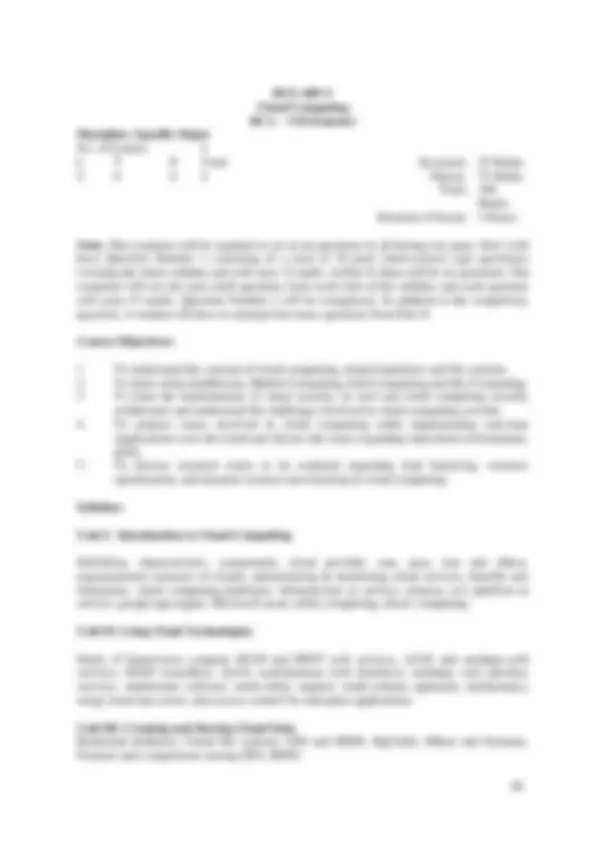
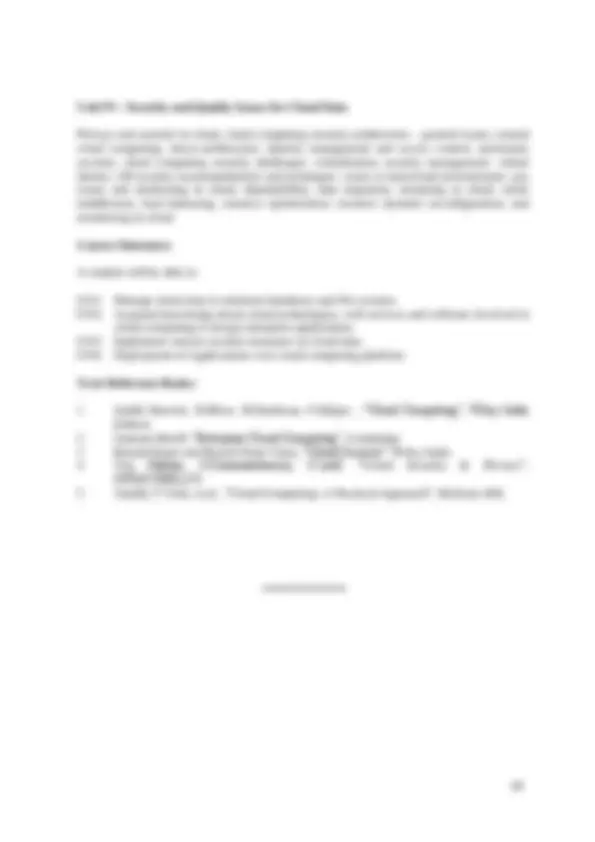
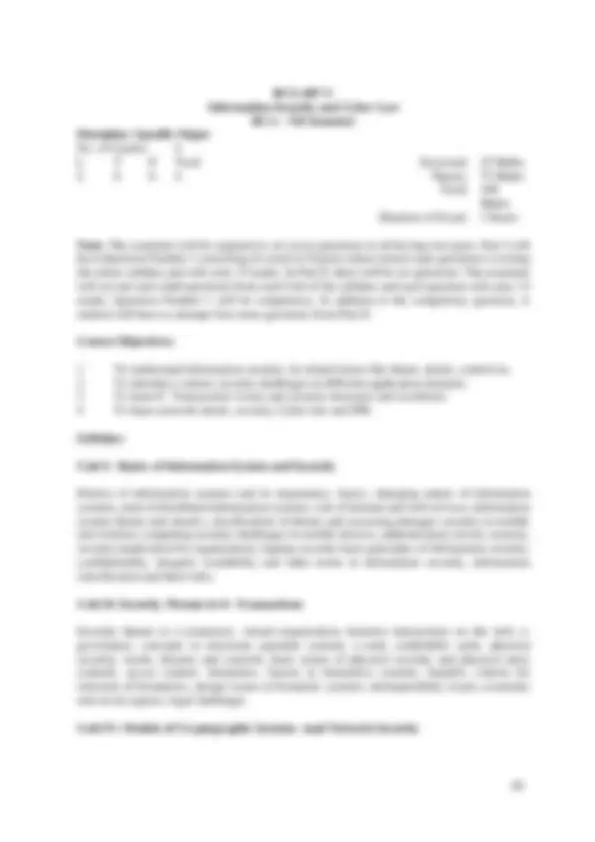
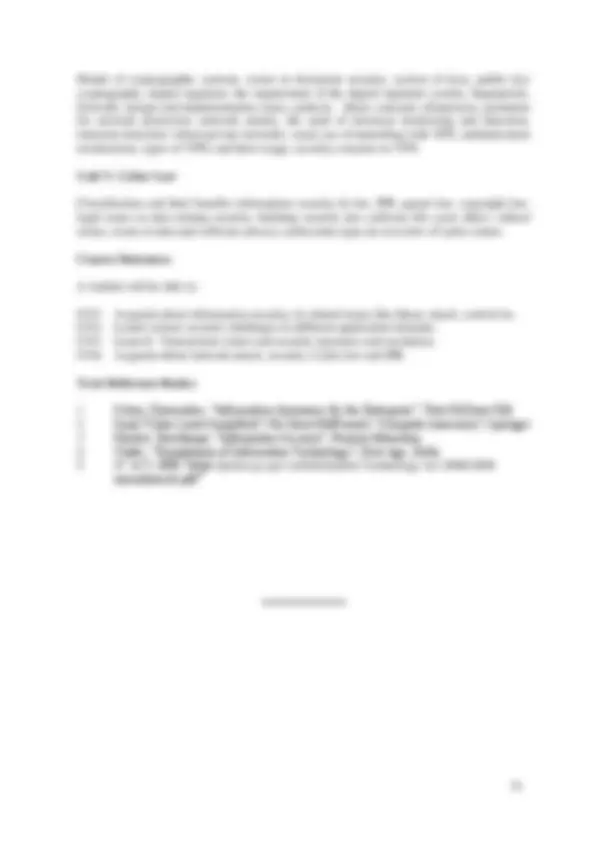
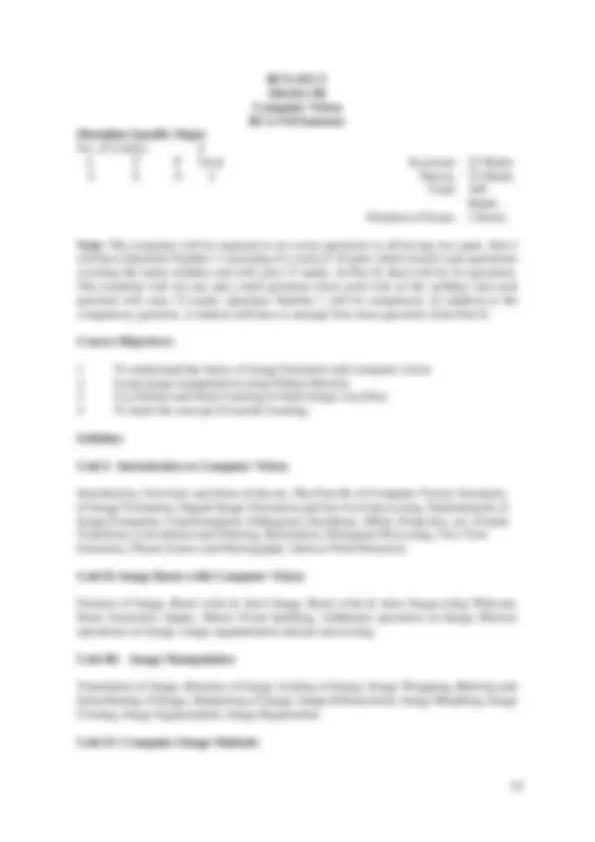
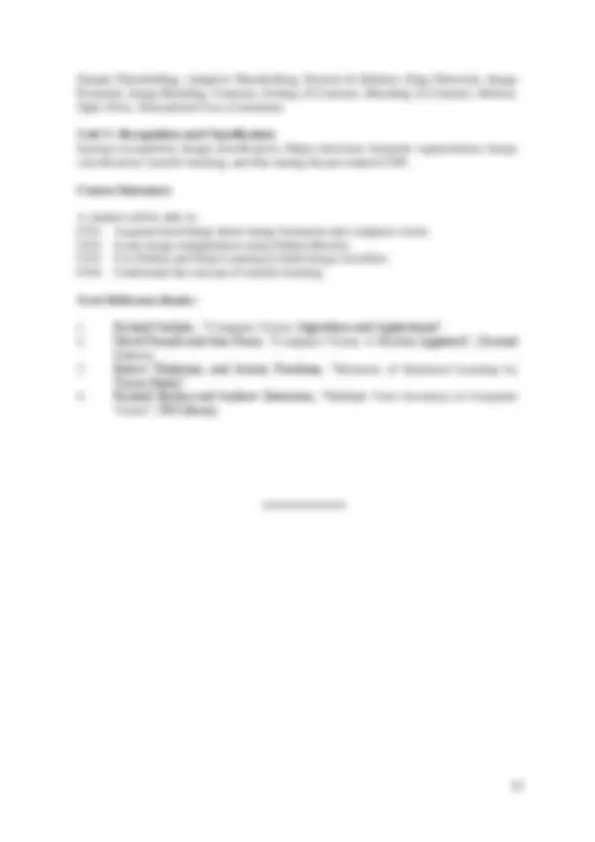
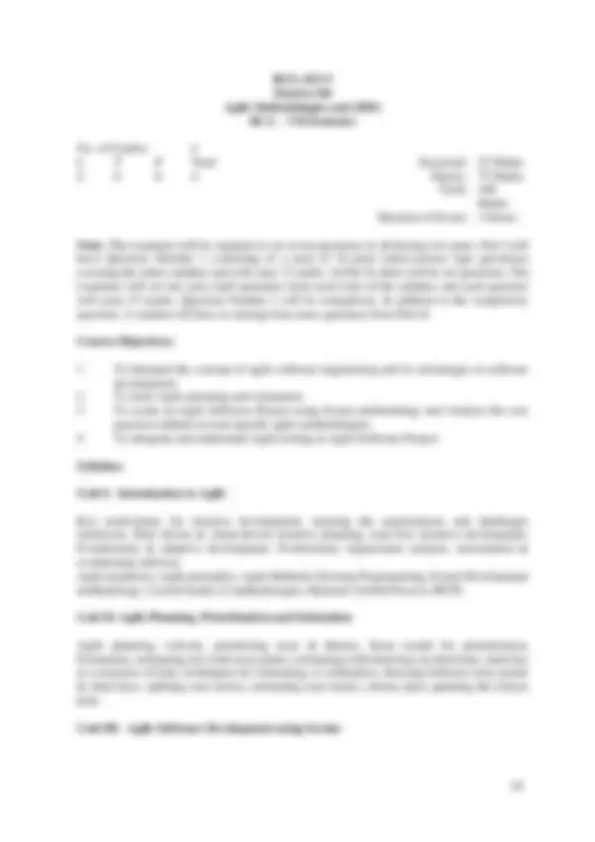
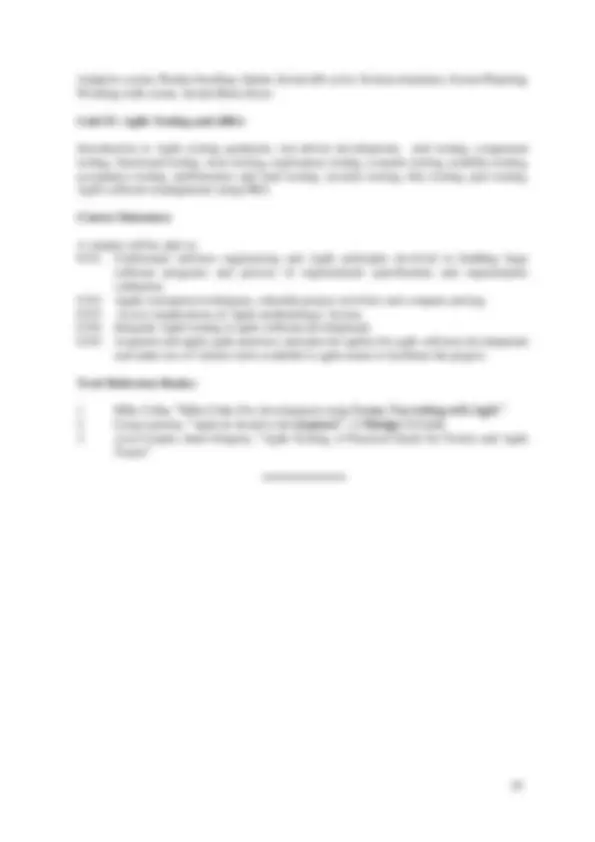
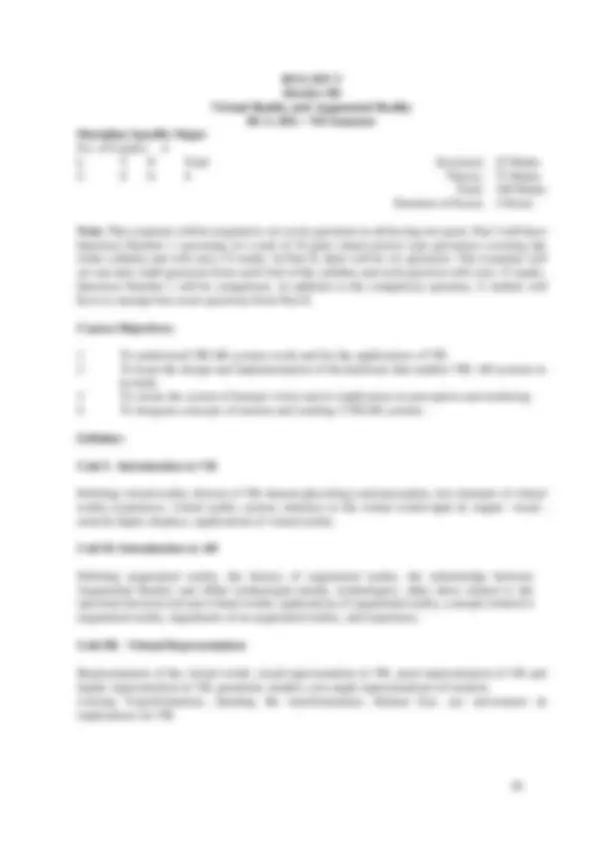
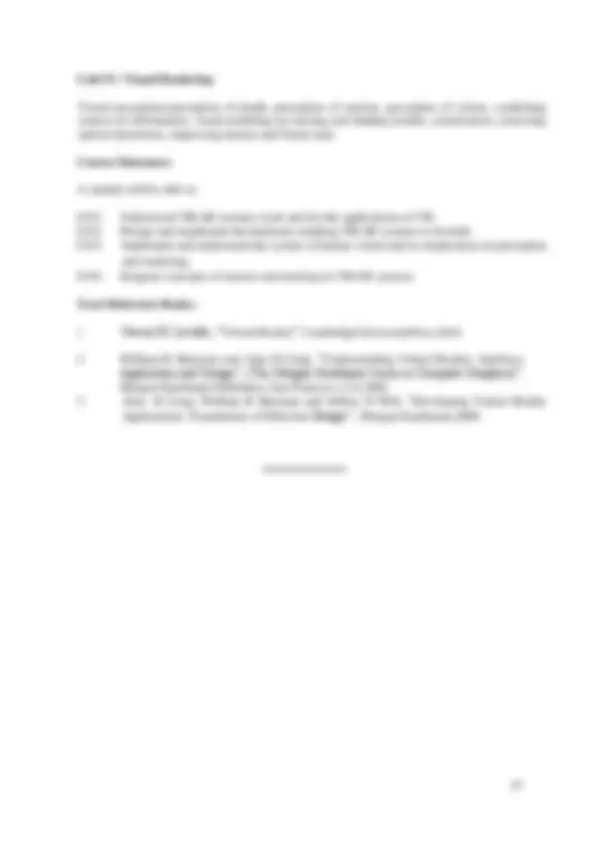
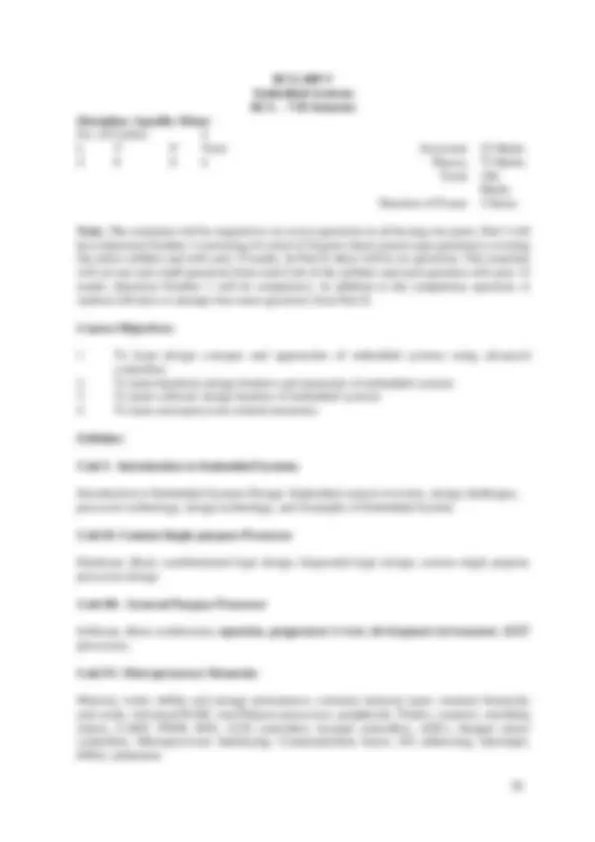
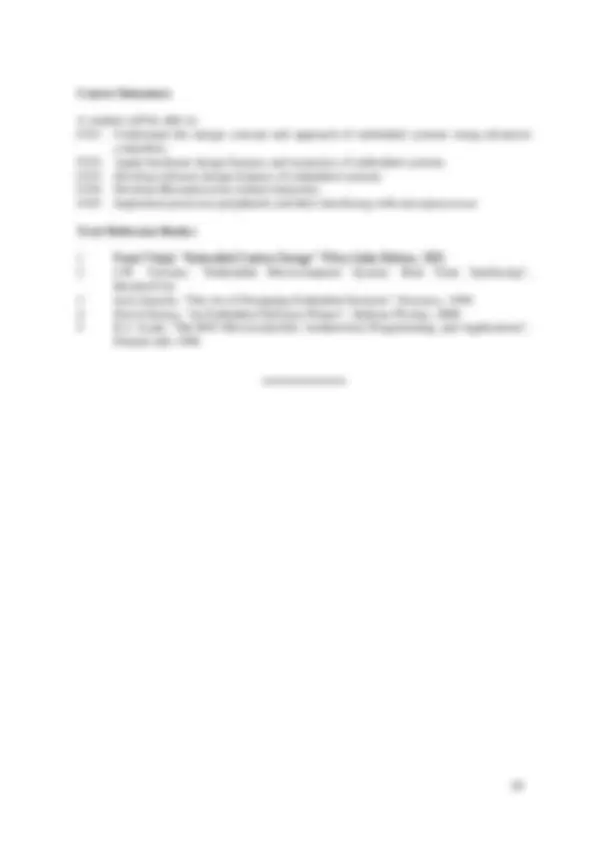
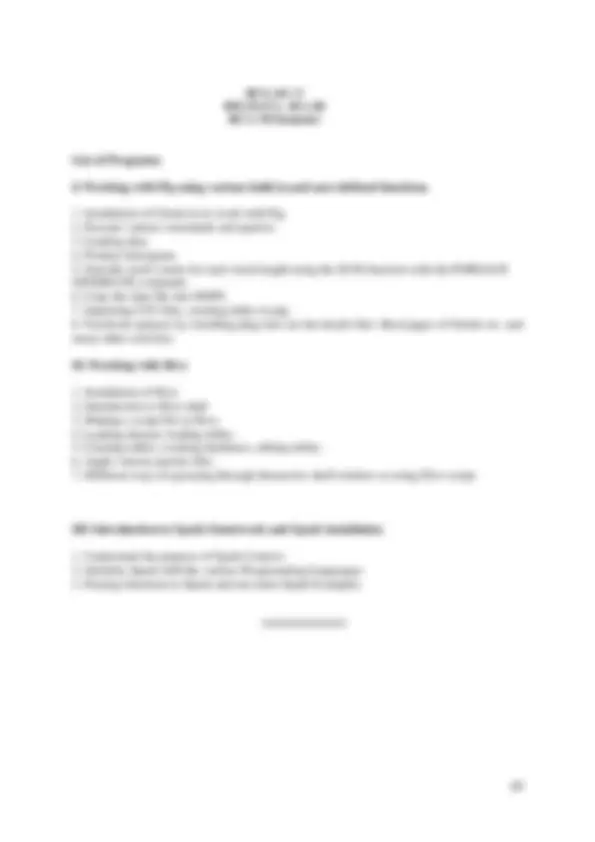
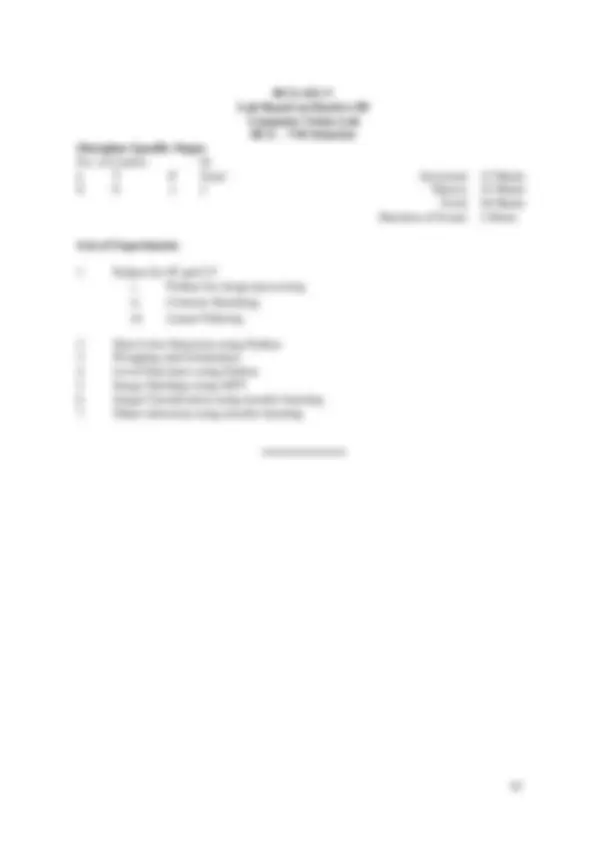
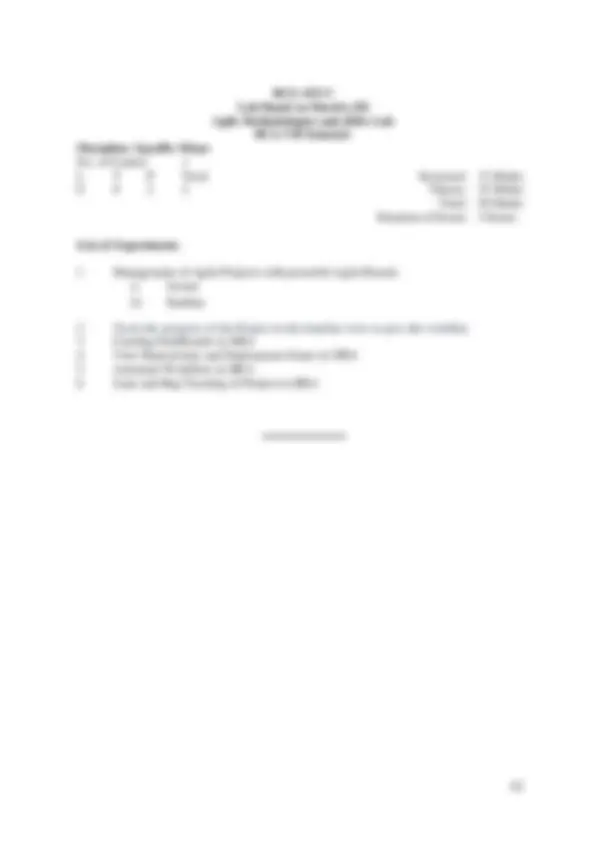
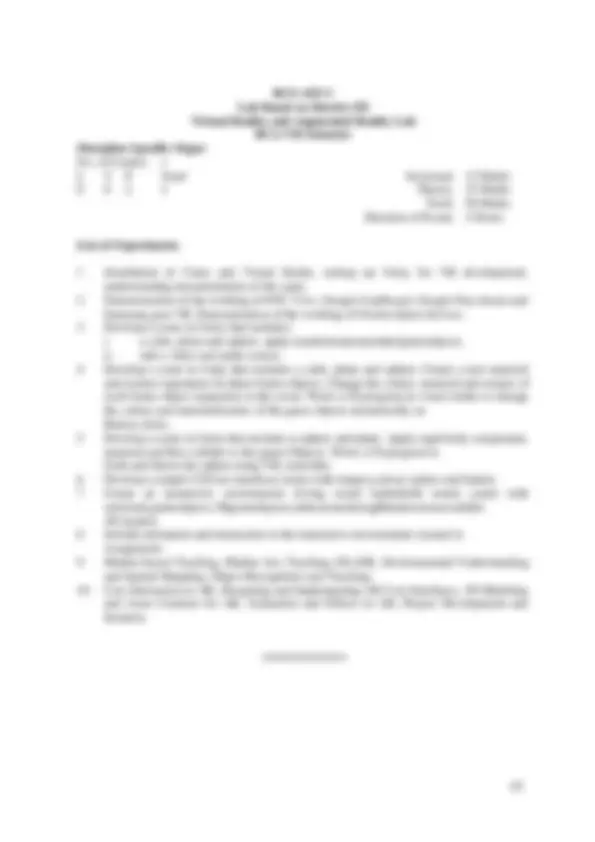


Study with the several resources on Docsity

Earn points by helping other students or get them with a premium plan


Prepare for your exams
Study with the several resources on Docsity

Earn points to download
Earn points by helping other students or get them with a premium plan
Community
Ask the community for help and clear up your study doubts
Discover the best universities in your country according to Docsity users
Free resources
Download our free guides on studying techniques, anxiety management strategies, and thesis advice from Docsity tutors
Technology department containing syllabi of BCA ds from ymca provided to the students of college.
Typology: Study Guides, Projects, Research
1 / 63

This page cannot be seen from the preview
Don't miss anything!
























































Department of Computer Applications
(Faculty of Informatics and Computing)
Scheme and Syllabus
BCA(Data Science)
(Semester V – VIII)
Scheme
(Semester V to VIII)
Sr. No
Category Course code
Course Title Course Requirements (hrs)
Sessional Marks/End Term Marks
Tota l Mar ks
Credi ts
L P Tot al
Sessi onal
End Term 1 Discipline Specific- Major
BCG- 302 - V C# Programming
3 3 25 75 100 3
2 Discipline Specific- Major
BCG- 304 - V Big Data-I 3 - 3 25 75 100 3
3 Discipline Specific- Major
BCG- 320 - V Machine Learning-II
3 - 3 25 75 100 3
4 Discipline Specific-Major
Elective-II 3 - 3 25 75 100 3
5 Discipline Specific- Minor
BCG- 308 - V High Speed Networks
4 4 25 75 100 4
6 Discipline Specific Lab
BCG- 310 - V C# Lab - 2 2 15 35 50 1
7 Discipline Specific Lab
BCG- 312 - V Big Data-I Lab - 2 2 15 35 50 1
8 Discipline Specific Lab
BCD- 302 - V Machine Learning-II Lab
Total 22 170 480 650 19
BCG-306-V: Data Warehousing & Data Mining BCG-322-V : Software Testing and Quality Assurance BCG-324-V : User Experience Design
Note* :Every student has to qualify three MOOC courses during the period of the course i.e. from Semester 1st to Semester 8th at any time (Applicable to 4 year degree programme) and the credit will be counted in the 8th^ semester only.
(BCA) - VII Semester
Sr. No
Category Course code
Course Title Course Requirements (hrs)
Sessional Marks/End-Term Marks
Total Marks
Credits
L P Total Sessional End Term 1 Discipline Specific- Major
BCG- 401 - V
Research Methodology
3 3 25 75 100 3
2 Discipline Specific- Major
BCG- 403 - V
BIG DATA II 3 - 3 25 75 100 3
3 Discipline Specific- Major
BCG- 405 - V
Cloud Computing
4 - 4 25 75 100 4
4 Discipline Specific- Major
BCG- 407 - V
Information Security and Cyber Law
4 - 4 25 75 100 4
5 Discipline Specific- Major
Elective - III 4 4 25 75 100 4
6 Discipline Specific- Minor
BCG- 409 - V
Embedded System
4 4 25 75 100 4
7 Skill Enhanceme nt Course
BCG- 411 - V
BIG DATA II Lab
8 Skill Enhanceme nt Course
BCA- 23 - 415
Lab Based on Elective-III
T otal (^26 180 520 700 )
BCG- 421 - V : Computer Vision BCG- 423 - V : Agile Methodologies and JIRA BCG- 425 - V : Virtual Reality and Augmented Reality
Note* :Every student has to qualify three MOOC courses during the period of the course i.e. from Semester 1st to Semester 8th at any time (Applicable to 4 year degree programme) and the credit will be counted in the 8th^ semester only.
JAVA Programming BCA-V Semester
No. of Credits: 3 L T P Total Sessional: 25 Marks 3 0 0 3 Theory: 75 Marks Total: 100 Marks Duration of Exam: 3 Hours
Note: The examiner will be required to set seven questions in all having two parts. Part I will have Question Number 1 consisting of a total of 10 parts (short-answer type questions) covering the entire syllabus and will carry 15 marks. In Part II, there will be six questions. The examiner will set one and a half questions from each Unit of the syllabus and each question will carry 15 marks. Question Number 1 will be compulsory. In addition to the compulsory question, A student will have to attempt four more questions from Part II.
Prerequisite: Basic understanding of programming concepts (like variables, control structures, and functions).
Course Objectives:
1 2
To learn basics of JAVA programming and its basic concepts and syntax. To implement program using inheritance and polymorphism. 3 4
To learn the concept of exception handling, and use of threading etc. To learn file I/O and be able to apply object oriented or non-object oriented techniques to solve bigger Real World Computing problems.
Syllabus:
Unit I: Java Language Basics
Introduction to Java, Basic Features, Java Virtual Machine Architecture and Concepts, Primitive Data Type and Variables, Java Operators, Expressions, Statements and Arrays.
Unit II: Classes, Inheritance and Polymorphism
Classes, objects; array of objects; objects as function arguments, scope resolution operator, static data members, inheritances, types of inheritance, containership, constructors and their types, polymorphism, abstract class, interface and packages.
Unit III Exceptions and Multithreading
Exception handling: exception handling in JAVA ‘tries and catch, throw and catch, throws and catch blocks’, multiple throw and catch blocks, throwing objects, exception classes, user defined exception.
Data Acquisition, Analysis and Visualization BCA-V Semester
No. of Credits: 3 L T P Total Sessional: 25 Marks 3 0 0 3 Theory: 75 Marks Total: 100 Marks Duration of Exam: 3 Hours
Note: The examiner will be required to set seven questions in all having two parts. Part I will have Question Number 1 consisting of a total of 10 parts (short-answer type questions) covering the entire syllabus and will carry 15 marks. In Part II, there will be six questions. The examiner will set one and a half questions from each Unit of the syllabus and each question will carry 15 marks. Question Number 1 will be compulsory. In addition to the compulsory question, A student have to attempt four more questions from Part II.
Prerequisite: Familiarity with data manipulation and analysis tools (like Excel, Python, or R).
Course Objectives:
1 Introduce students about Big Data, Hadoop, NoSQL and other open source technologies. 2 3
Familiarize students with building a big data strategy and components Data Impart knowledge about big data modeling and management 4 Acquaint students about Data Acquisition and Data Analysis
Syllabus:
Unit I: Introduction
Big Data: Introduction, characteristics, types, sources, examples, technologies; integrating diverse data; introduction to Hadoop, open source technologies, Introduction to NoSQL, aggregate data models.
Unit II: Big Data Modeling and Management
Data Science: Getting Value out of Big Data, Building a Big Data Strategy, Five Components of Data Science, Five P's of Data Science. Steps in the Data Science Process. Big Data Modeling and Management: Data Ingestion, Data Storage, Data Quality, Data Operations, Data Scalability and Security, Real Big Data Management Applications.
Unit III: Data Acquisition
Real time data acquisitition, Review of transducer, Introduction about Instrumentation system. Types of Instrumentation system. Data acquisition system and its uses in intelligent
Instrumentation system. Detail study of each block involved in making of DAS, Signal conditioners as DA, IA, signal converters (ADC), Sample and hold. Designing application for Pressure, Temperature measurement system using DAS. Data logger
Unit IV: Data Analysis
Introduction, various techniques like Classification, regression, clustering, association analysis, and graph analysis. MapReduce workflows, anatomy of MapReduce job run, classic Map Data Analysis: Introduction, various techniques like Classification, regression, clustering, association analysis, and graph analysis. MapReduce workflows, anatomy of MapReduce job run, classic Map
Course Outcomes:
A student will be able to: CO1: Understand basics of Big Data CO2: Build an effective big data strategy CO3: CO4:
Implement Big data modeling and management Design data Acquisition System
Text/ Reference Books:
1 Tom White, “Hadoop: The Definitive Guide” Third Edit on, O‟reily Media,
2 SeemaAcharya, SubhasiniChellappan, "Big Data Analytics" Wiley 2015. 3 Michael Berthold, David J. Hand, "Intelligent Data Analysis”, Springer, 2007. 4 Jay Liebowitz, “Big Data and Business Analytics” Auerbach Publications, CRC press (2013) 5 Tom Plunkett, Mark Hornick, “Using R to Unlock the Value of Big Data: Big Data Analytics with Oracle R Enterprise and Oracle R Connector for Hadoop”, McGrawHill/Osborne Media (2013), Oracle press.
Scalable Machine Learning, Introduction to Bayesian Learning and Inference, Recent trends in various learning techniques of machine learning and classification methods.
Course Outcomes:
A student will be able to: CO1: Understood basic concepts and types of Machine Learning techniques. CO2: Compare and contrast pros and cons of various machine learning techniques and to get an insight of when to apply a particular machine learning approach. CO3: Understand the strength and weaknesses of various supervised and un-supervised techniques for the solving a real - world problem. CO4: Get an insight about real life applications of ML.
Text/ Reference Books:
1 Kevin Murphy,” Machine Learning: A Probabilistic Perspective”, MIT Press, 2012 2 Trevor Hastie, Robert Tibshirani, Jerome Friedman, “The Elements of Statistical Learning”, Springer 2009 (freely available online) 3 EthemAlpaydin, Introduction to Machine Learning 3e (Adaptive Computation and Machine Learning Series) ‖, Third Edition, MIT Press, 2014 4 Tom M Mitchell, ―Machine Learning‖, First Edition, McGraw Hill Education.
Software Engineering(Elective-I) BCA-V Semester
No. of Credits: 3 L T P Total Sessional:
25 Marks
3 0 0 3 Theory:
75 Marks
Total:
100 Marks
Duration of Exam: 3 Hours
Note: The examiner will be required to set seven questions in all having two parts. Part I will have Question Number 1 consisting of a total of 10 parts (short-answer type questions) covering the entire syllabus and will carry 15 marks. In Part II, there will be six questions. The examiner will set one and a half questions from each Unit of the syllabus and each question will carry 15 marks. Question Number 1 will be compulsory. In addition to the compulsory question, A student will have to attempt four more questions from Part II.
Course Objectives:
1 To understand need of software engineering and fundamental principles of Software Engineering 2 3
To understand various software models and SRS designs principles. To analyse various software project concepts and how project planning is done using various phases. 4 To apply the various techniques in software designing and software testing using test cases.
Syllabus:
Unit I: Introduction
Software Crisis, Software Processes & Characteristics, Software life cycle models, Waterfall, Prototype, Evolutionary and Spiral Models.
Unit II: Software Requirements Analysis & Specifications
Requirement engineering, requirement elicitation techniques like FAST, QFD, requirements analysis using DFD, Data dictionaries & ER Diagrams, Requirements documentation, Nature of SRS, Characteristics & organization of SRS.
Unit III: Software Project Management Concepts and Software Project Planning
The Management spectrum, The People, The Problem, The Process, The Project.
User Interface Design(Elective-I) BCA-V Semester
No. of Credits: 3 L T P Total Sessional: 25 Marks 3 0 0 3 Theory: 75 Marks Total: 100 Marks Duration of Exam: 3 Hours
Note: The examiner will be required to set seven questions in all having two parts. Part I will have Question Number 1 consisting of a total of 10 parts (short-answer type questions) covering the entire syllabus and will carry 15 marks. In Part II, there will be six questions. The examiner will set one and a half questions from each Unit of the syllabus and each question will carry 15 marks. Question Number 1 will be compulsory. In addition to the compulsory question, A student will have to attempt four more questions from Part II.
Course Objectives:
1 To Understand UI Design. 2 3
To learn color scheme for different projects. To create Logo design principles.
4 To integrate UI principle in UI design 5 To develop Mockups.
Syllabus:
Unit I: Introduction to UI Design
Introduction to Photoshop - Raster graphics - Performance Optimization - Color Calibration Workspace overview - Photoshop controls - Interface - Layers and Panels - Navigation Pan - Rotate View tool - Navigator panel - Zoom in or out - Fit an image to the screen- Photoshop Tools - Usability features - Masks in UI Design - Lights and Shadows - Emphasis and Blending.
Unit II: Color Scheme
Color Scheme - Primary Color - Secondary colors - Neutral colors - Brainstorm - Typography
Unit III: Logo Design Principles
Logo Design Principles - Purpose - Target audience - Planning essentials - Web Layout Design
Unit IV: UI Illustrations
UI Illustrations - Creating visual triggers - Creative storytelling - Emotional appeal - Aesthitic satisfaction - Mobile GUI Design - Mobile GUI Guidelines - Android UI Design - Screen Components - IOS UI Design - Animations - UI Animations in Photoshop - UI Animation in Illustrator.
Unit V: Mockup Design
Mockup Design - Responsive Web Design - Setting the stage - Basic mechanics - Typography and Layout - Navigation patterns - Advanced Enhancement - Performance - Page Designs - Metro UI Design - Mascot Design - Characters Purpose - Unique features - Exporting for Web, Mobile, Print - Design Optimization.
Course Outcomes:
A student will be able to: CO1: Understand UI Design. CO2: Design color scheme for different projects. CO3: Implement Logo design principles. CO4: CO5:
Integrate UI principle in UI design Acquaint mockups in different projects
Text/ Reference Books:
1 Diana MacDonald, “Practical UI Patterns for Design Systems: Fast- Track Interaction Design for a Seamless User Experience”, Apress, 2019. 2 Jenifer Tidwell, “Designing Interfaces: Patterns for Effective Interaction Design” Second Edition, O'Reilly Media, Inc., 2010 3 R. Moore “UI design with Adobe Illustrator”, Berkely, California: Adobe Press,
4 Lesa Snider, “Photoshop CS6: The Missing Manual”, 2nd Edition, O'Reilly Media Publisher, 2012
Unit IV: Image Segmentation
Detection of discontinuities, edge linking and boundary detection, thresholding – global and adaptive, region-based segmentation
Unit V: Image Compression
Redundancy, inter-pixel and psycho-visual, Lossless compression predictive, entropy, Lossy compression, predictive and transform coding, Discrete Cosine Transform, Still image compression standards, JPEG and JPEG-2000.
Unit VI: Wavelets and Multi-resolution image processing:
Uncertainty principles of Fourier Transform, Time-frequency localization, continuous wavelet transforms, wavelet bases and multi-resolution analysis, wavelets and Subband filter banks, wavelet packets
Course Outcomes:
A student will be able to: CO1: Mathematically represent the various types of images and analyze them. CO2: Process these images for the enhancement of certain properties or for optimized use of the resources. CO3: Understand the purpose of Image segmentation. CO4: Develop algorithms for image compression and coding.
Text/ Reference Books:
1 R.C. Gonzalez and R.E. Woods, “Digital Image Processing”, Second Edition, Pearson Education 3rd edition 2008. 2 Anil Kumar Jain, “Fundamentals of Digital Image Processing”, Prentice Hall of India.2nd edition 2004. 3 Murat Tekalp , “Digital Video Processing", Prentice Hall, 2nd edition 2015.
Speech and Audio Processing BCA-V Semester
No. of Credits: 4 L T P Total Sessional: 25 Marks 4 0 0 4 Theory: 75 Marks Total: 100 Marks Duration of Exam: 3 Hours
Note: The examiner will be required to set seven questions in all having two parts. Part I will have Question Number 1 consisting of a total of 10 parts (short-answer type questions) covering the entire syllabus and will carry 15 marks. In Part II, there will be six questions. The examiner will set one and a half questions from each Unit of the syllabus and each question will carry 15 marks. Question Number 1 will be compulsory. In addition to the compulsory question, A student will have to attempt four more questions from Part II.
Course Objectives:
1 To familiarize the basic mechanism of speech production and the basic concepts of methods for speech analysis and parametric representation of speech. 2 To give an overall picture about the Linear Prediction and quantization of speech. 3 To impart ideas of Spectral distortion measures and Linear Prediction Coding Perception and rendering. 4 To introduce Code Excited Linear Prediction
Syllabus:
Unit I: Introduction and Speech Signal Processing Speech production and modelling - Human Auditory System; General structure of speech coders; Classification of speech coding techniques – parametric, waveform and hybrid; Requirements of speech codecs – quality, coding delays, robustness. Speech Signal Processing-: Pitch-period estimation, all-pole and all-zero filters, convolution; Power spectral density, periodogram, autoregressive model, autocorrelation estimation.
Unit II: Linear Prediction of Speech and Speech Quantization Basic concepts of linear prediction; Linear Prediction Analysis of non-stationary signals – prediction gain, examples; Levinson-Durbin algorithm; Long-term andshort-term linear prediction models; Moving average prediction. Scalar quantization–uniform quantizer, optimum quantizer, logarithmic quantizer, adaptive quantizer, differential quantizers; Vector quantization: distortion measures, codebook design, codebook types.
Unit III: Scalar Quantization of LPC and Linear Prediction Coding
Spectral distortion measures, Quantization based on reflection coefficient and log area ratio, bit allocation; Line spectral frequency: LPC to LSF conversions, quantization based on LSF. Linear Prediction Coding- LPC model of speech production; Structures of LPC encoders and decoders; Voicing detection; Limitations of the LPC model.